Turn Flooding Into an Asset: Water-Smart Landscape Design That Works
Water is essential to life and connects everything in our environment. In nature, healthy landscapes act like sponges — they soak up water, filter it, store it, and slowly release it. This process helps prevent flooding, recharge groundwater, keep water clean, and support plants, wildlife, and people. When land is developed, these natural systems are often disrupted. Thoughtful site design can bring them back by encouraging water to soak into the ground, evaporate, and flow in a balanced way. Well-designed landscapes and buildings can work with the water cycle, not against it — protecting natural water sources while creating resilient, attractive places.
The Role of Water
The water we see every day — from a bubbling creek to a calm lake, from falling rain to drifting snow and clouds — is all part of the water cycle. This cycle describes how water moves through and around our planet. Key parts include:
- Precipitation – water forming in the atmosphere and falling to the ground, such as rain and snow
- Evapotranspiration – water returning to the air from the land, water surfaces, and plants
- Surface runoff – rain or snowmelt flowing over the ground and downhill
- Recharge – water soaking into the soil (infiltration) and moving down (percolation) to refill underground aquifers
- Discharge – water emerging from underground and feeding into surface water bodies, such as rivers, lakes, or oceans
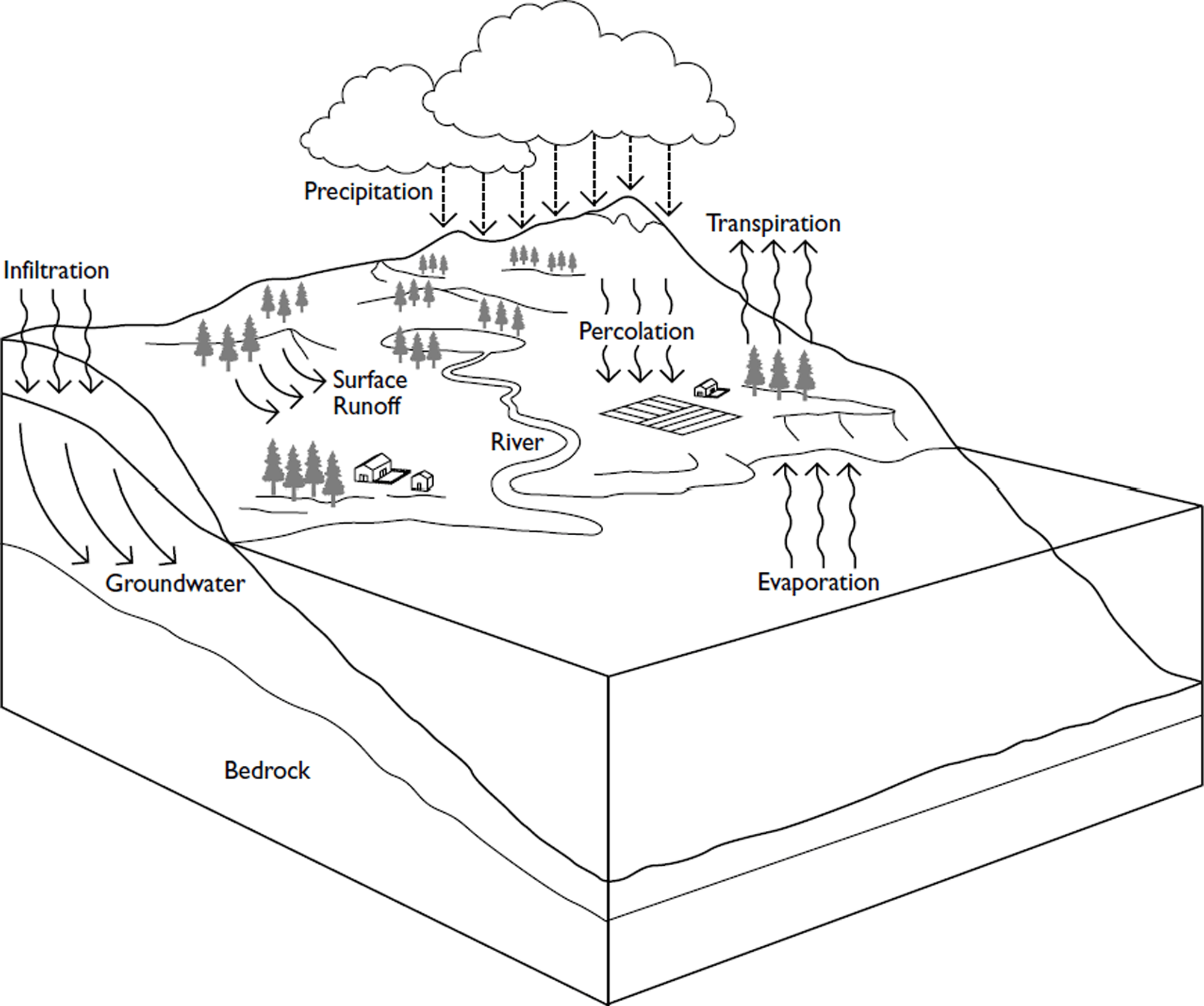
While the water cycle remains balanced across the planet, it can be disrupted at a local or regional scale. Development often diverts rainwater away from its natural paths of infiltration, evapotranspiration, and runoff. In developed areas, these changes disrupt important parts of the cycle — filtration, infiltration, evapotranspiration, surface storage, recharge, and stream flow. In a built environment, impervious surfaces like pavements and rooftops prevent water from infiltrating. During storms, runoff carries pollution from these surfaces and is quickly drained away, reducing groundwater recharge on site and altering the natural movement of water.
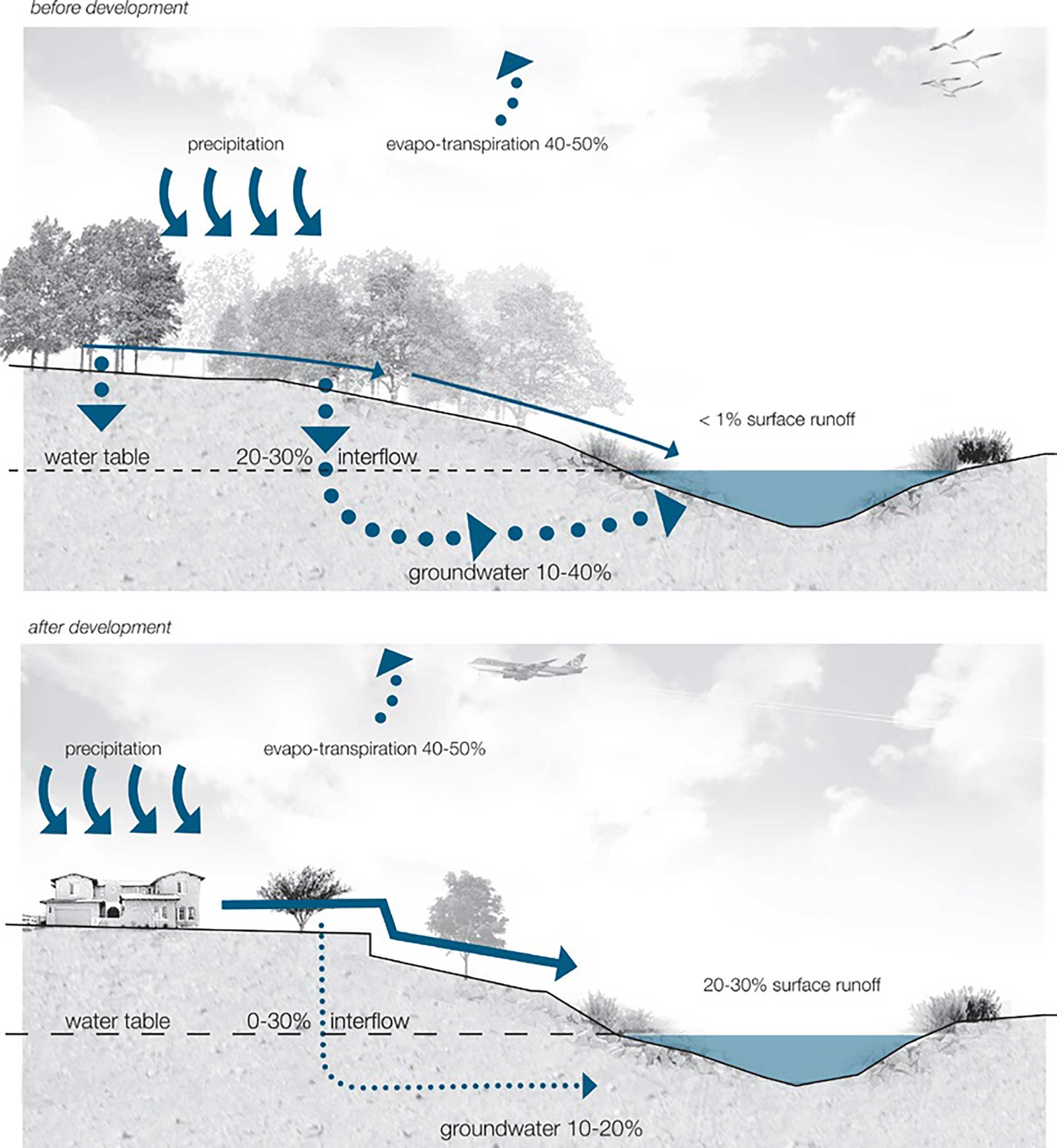
Common Development Challenges
When development disrupts the natural water cycle, it can lead to a range of problems, including higher flood risk, reduced water supply, declining water quality, and weaker community resilience. These impacts can also harm local habitats and cause ecosystems to break down. In this section, we’ll focus on two of the common and pressing challenges: increased flooding risks and water quality degradation.
Increased Flooding Risks
Flooding happens when water overflows onto land that’s normally dry. Streams and rivers naturally rise with runoff from rainfall or snowmelt, but flooding occurs when runoff reaches them in large volumes quickly. Development can significantly increase this risk. In urban areas, roads, roofs, parking lots, and sidewalks replace natural vegetation and permeable soil, reducing the land’s ability to store water and allow infiltration. These impervious surfaces speed up runoff, directing it into ditches, culverts, and storm drains that quickly deliver water to water bodies. Even in suburban areas with lawns, shallow or compacted soil can become saturated quickly, resulting in rapid overland flow.
When development occurs along stream channels or floodplains, it can further worsen flooding. Structures like bridges and buildings may narrow the channel, slowing water and causing it to back up upstream. Sediment and debris carried by floodwaters can clog channels, while channel straightening and vegetation removal increase flow speed and erosion. Together, these changes raise flood peaks, increase flood frequency, and expand the areas affected by high water.
Water Quality Degradation
Water quality often declines when pollutants are carried into streams, lakes, and wetlands. In developed areas, chemicals, oils, heavy metals, and other contaminants accumulate on impervious surfaces, such as roads, parking lots, and rooftops. Rain washes these pollutants into storm drains and waterways — a process known as nonpoint source pollution. Heated pavement can also warm runoff, raising stream temperatures. Warmer water holds less dissolved oxygen, stressing aquatic life. Agricultural fields, golf courses, lawns, and feedlots add fertilizers, pesticides, and animal waste. Excess nutrients from fertilizers and waste can lead to eutrophication — a process in which nutrient levels in water rise, fueling excessive plant growth and algae bloom. Algae blooms block sunlight, reduce oxygen as they decompose, and sometimes release toxins, creating unsafe conditions for wildlife and humans. Point source pollution, such as discharges from industrial or municipal facilities, can further degrade water. Poor water quality harms aquatic habitats, reduces biodiversity, and limits human uses like swimming, fishing, and enjoying natural beauty.
Our land-use choices directly impact ecology, water quality, runoff, agricultural productivity, and overall quality of life. To build thriving, resilient communities, future development should protect or restore the natural services that healthy ecosystems provide, while using resources wisely and efficiently.
Design for Stormwater Management
Addressing flooding and water quality challenges starts with designing landscapes and infrastructure that work in harmony with the natural water cycle. Because natural water systems are complex and hard to predict, stormwater management should work with them, making as few changes as possible or helping to restore their balance. Effective design aims to:
- Preserve and restore the natural relationship between rainfall, vegetation, and soil
- Encourage rainfall and runoff to soak into the ground where it falls
- Protect and improve the quality of rivers, lakes, and other surface waters
- Support groundwater recharge
- Maintain stream baseflow at predevelopment levels
- Treat wastewater on-site whenever possible
- Reuse or infiltrate treated wastewater on site
- Reduce reliance on potable (drinking) water
- Capture and reuse rainwater, graywater, and treated blackwater on site
Reducing Runoff
A key step in sustainable stormwater management is preventing additional runoff in the first place. Wherever possible, preserve undeveloped land and restore natural areas so they can continue to absorb and filter rainwater. Direct new development toward previously used sites, and when redeveloping, restore vegetation that reflects the diversity and structure of native plant communities.
On developed sites, minimize impervious surfaces by reducing building footprints and road lengths, using green roofs, or installing pervious pavements. Incorporate green infrastructure — such as rain gardens, grass swales, and bioretention ponds — to slow runoff, delay peak flows, and enhance infiltration and evaporation.
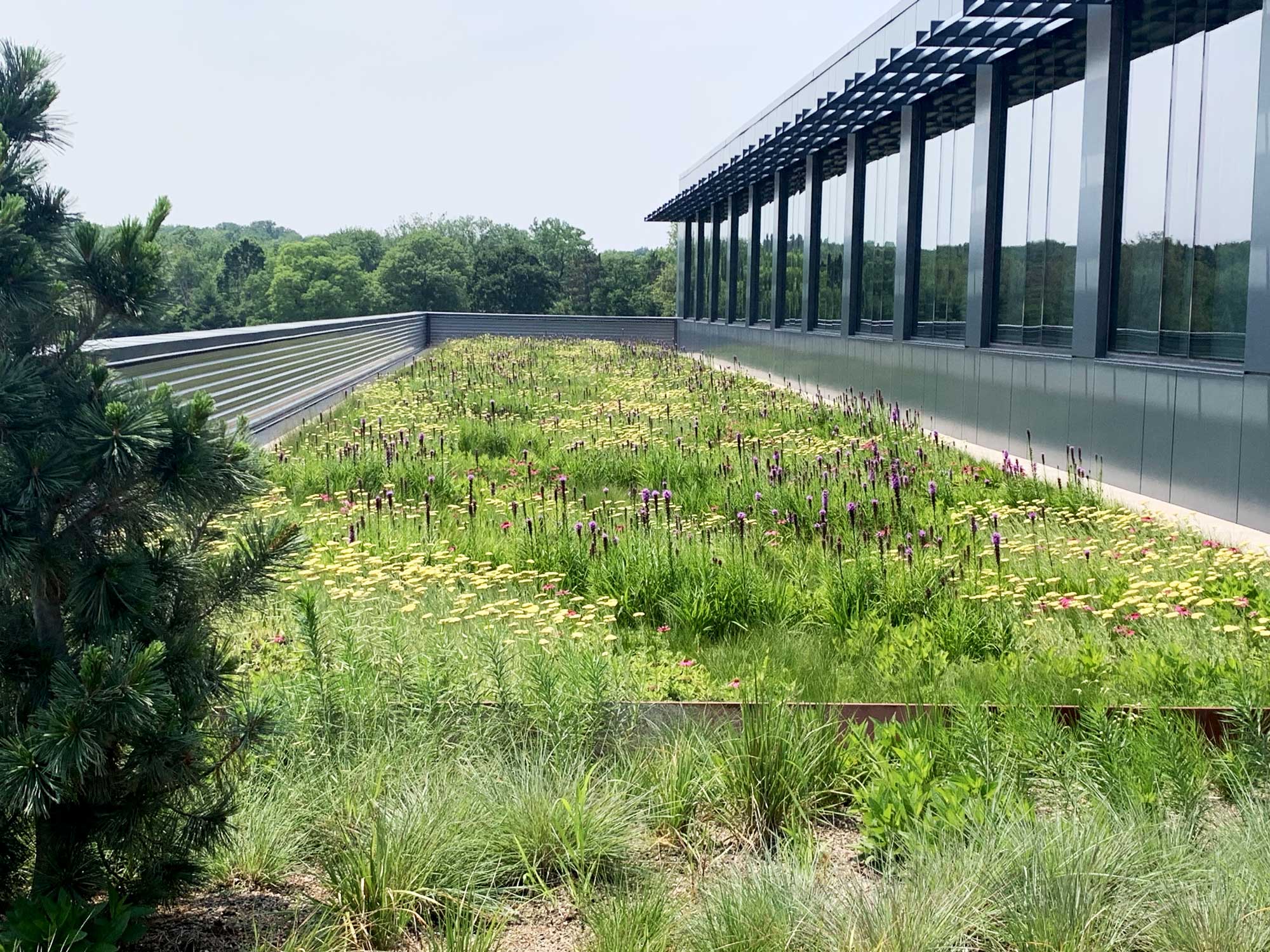
Rainwater harvesting systems capture runoff from rooftops or other surfaces, filter it, and store it in rain barrels, cisterns, ponds, or dry wells. This stored water can be reused for irrigation or other nonpotable purposes.
Erosion and Sediment Control
Without well-planned and maintained measures, construction, land disturbance, or even some restoration activities can harm nearby streams, lakes, and wetlands. Erosion occurs when soil is loosened by rain, wind, or freeze–thaw cycles and then carried away. Sediment is the soil and mineral particles that are detached and transported by these forces, often ending up in waterways where they may impact aquatic life and water quality. The best approach is to prevent erosion before it starts — by minimizing disturbed area, limiting clearing, and preserving existing vegetation. Where disturbance is unavoidable, stabilize the soil quickly with ground cover, and protect drainage channels to reduce the chance of soil particles being detached and transported.
Protect or Restore Receiving Water Bodies
Protecting and restoring streams, lakes, and other water bodies starts with slowing runoff, reducing erosion, and improving water quality before it enters natural waterways. Constructed wetlands and other treatment features can help achieve these objectives.
Stream restoration and enhancement focus on creating balanced, stable channels that can safely carry water and sediment under current watershed conditions. This often involves reconnecting streams with their floodplains, reestablishing native riparian vegetation, and minimizing the use of culverts or other crossing structures that interrupt natural flow. By restoring these connections and stabilizing stream banks, healthy aquatic habitats are protected, and the water system can better absorb and manage stormwater naturally.
Amenity Opportunities
Stormwater features don’t have to be purely functional; they can also enhance the beauty and enjoyment of a site. Modern stormwater management techniques, which address water quality, balance, and storm flows, can be designed as attractive landscape elements rather than hidden underground pipes. Open drainage systems can follow natural landforms and integrate seamlessly with site uses, becoming a central part of the design.
When stormwater features are treated as amenities, they can serve multiple purposes. Educational opportunities arise when the design encourages people to learn about rainwater, water cycles, and sustainable practices. Recreational opportunities focus on playful or relaxing interactions with the water — areas where people can enjoy, explore, or be refreshed by the presence of water. This approach combines function with enjoyment, making stormwater management both practical and engaging.
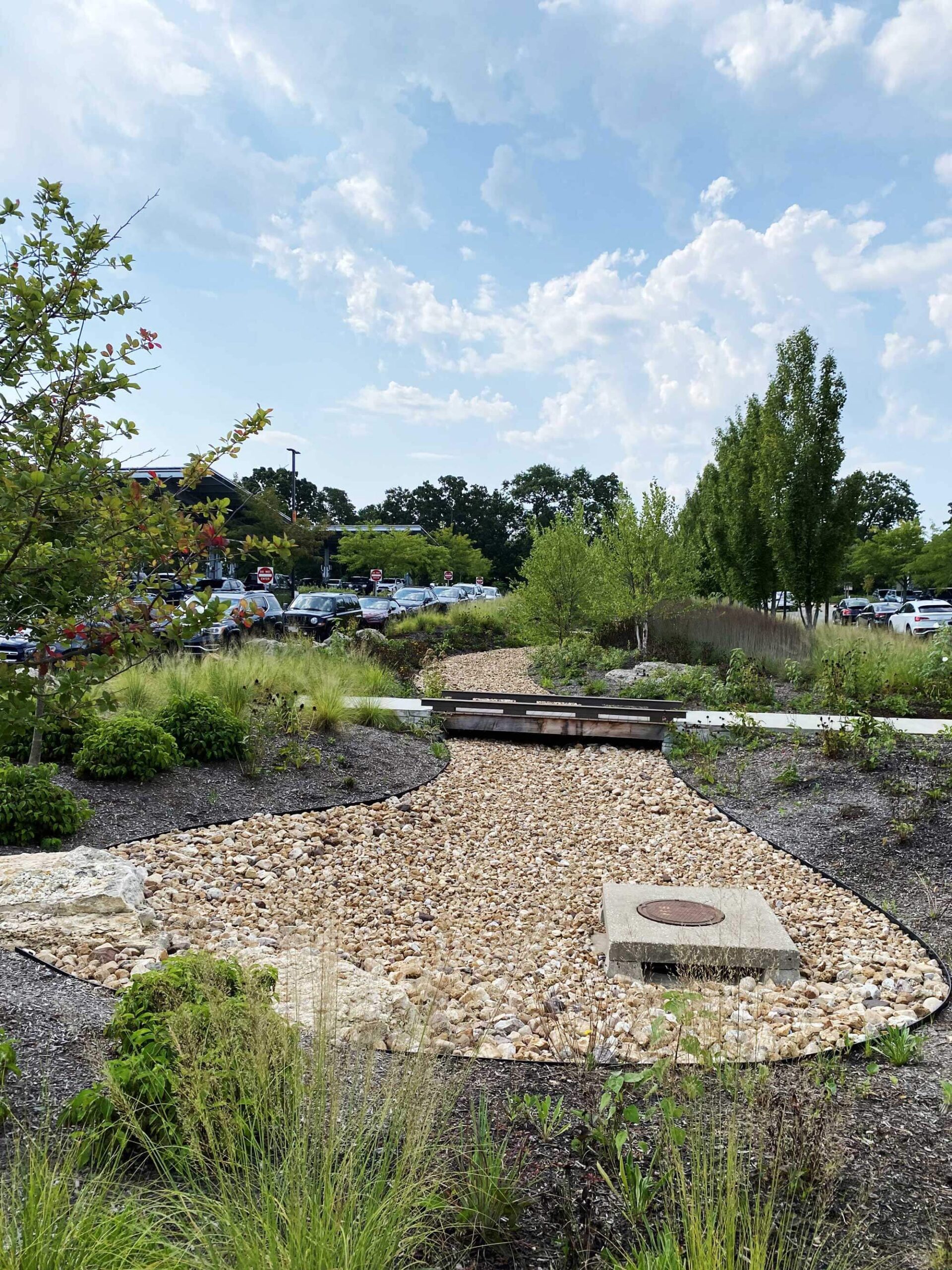
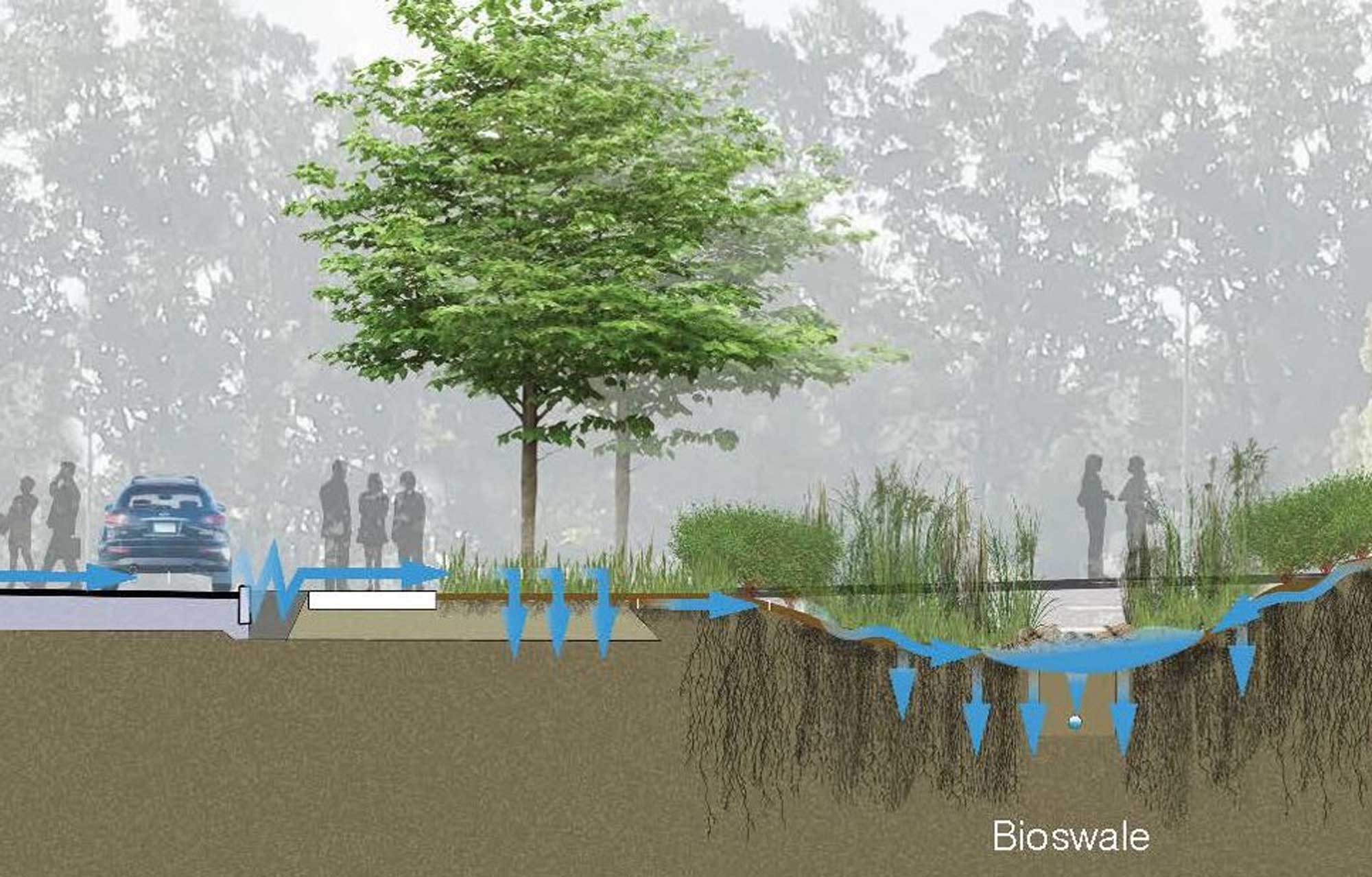
By carefully managing stormwater on site, we can reduce flooding, protect water quality, restore natural waterways, and even create attractive, educational, and recreational features.
Designing for Water Conservation
A smart approach to water conservation is to balance the water available on a site — from rainwater, recycled, or reclaimed sources — with the landscape’s needs. Sustainable site design focuses on creating healthy, vibrant, and attractive landscapes using water as a renewable resource, without drawing down drinking water or harming local groundwater, streams, or aquatic habitats.
Recycling and Reusing Water
Many sites generate extra water from rooftops, paved areas, or building operations. By capturing this water, storing it, and using it during dry periods, we can create a balanced water supply that supports a wider variety of landscape features while maintaining natural hydrology.
On-site treatment can remove pollutants and lower water temperature, making it safe for nonpotable uses. Reclaimed water can be used for irrigation, water features where people don’t come into direct contact, or for building needs like cooling systems or toilet flushing. This approach reduces reliance on drinking water while enhancing the site’s sustainability and resilience.
Efficient Water Use
Minimizing irrigation needs requires a combination of thoughtful design, plant selection, and maintenance strategies. Healthy soil rich in nutrients and organic matter helps plants thrive and retain moisture naturally. Choosing climate-appropriate native or adapted plants reduces or eliminates the need for supplemental watering once they are established. Sustainable maintenance practices, such as integrated pest management (IPM), help reduce plant stress and create a stable, resilient landscape. When irrigation is necessary, slow, deep, and infrequent watering encourages stronger root systems and uses water efficiently.
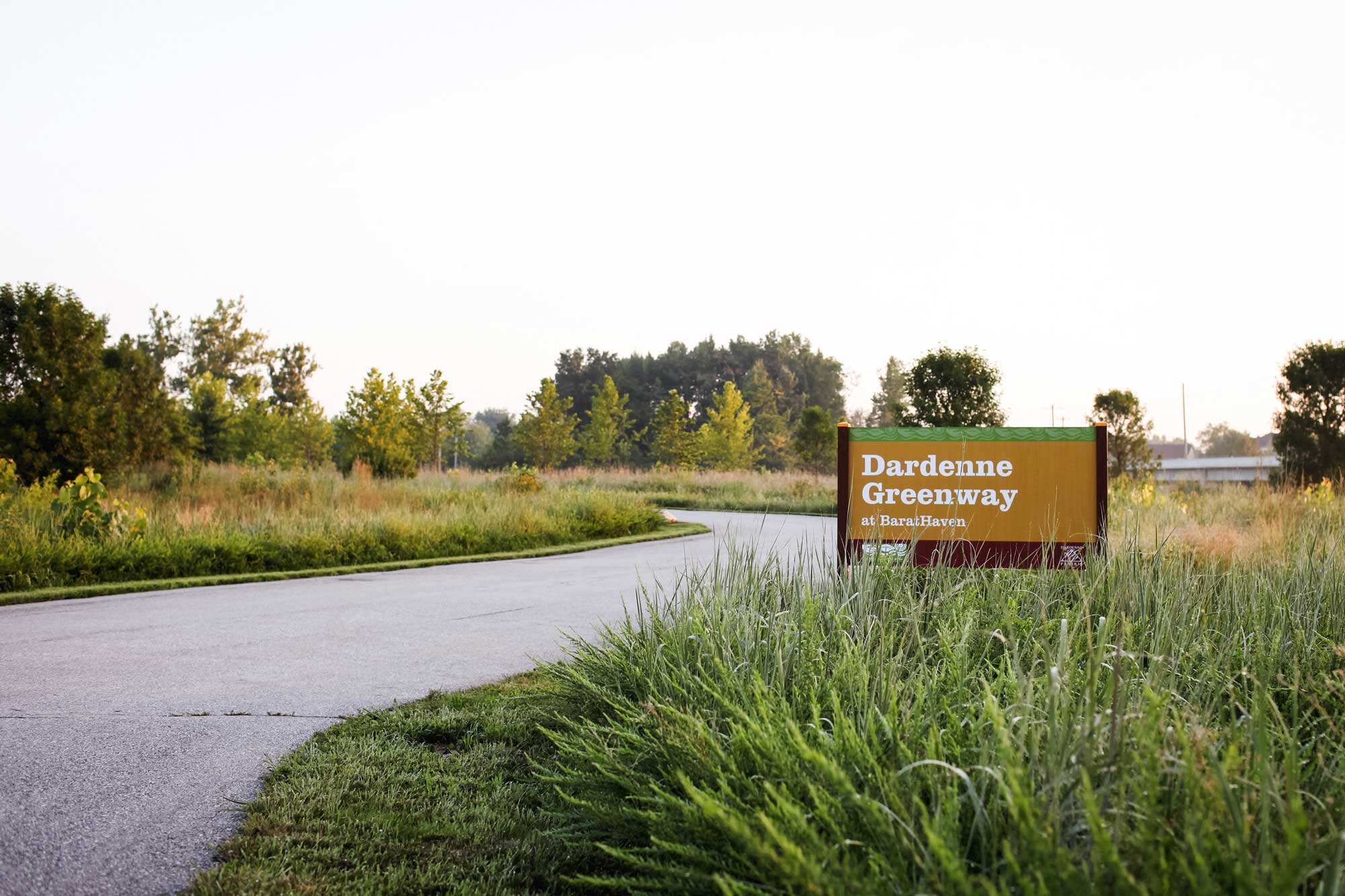
Water features and water play areas can also be designed to conserve water. Features are better to recycle their own water, minimizing manual replenishment and unnecessary loss. Dual-purpose designs can serve as stormwater infrastructure, wildlife habitat, or naturalized water elements. Interactive water play can operate only when in use, with water recaptured for nonpotable reuses. Together, these strategies conserve water while supporting healthy, vibrant, and functional landscapes.
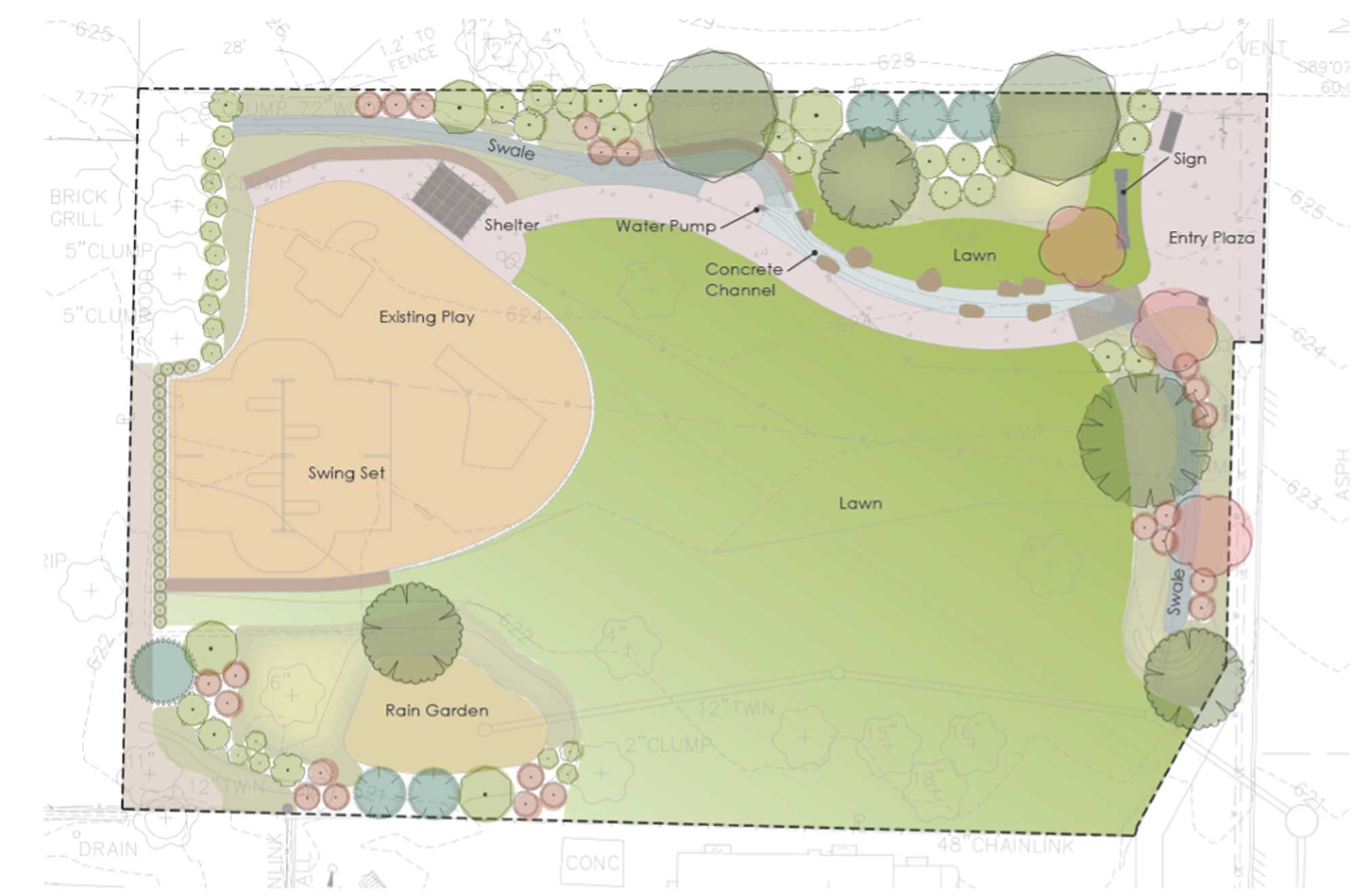
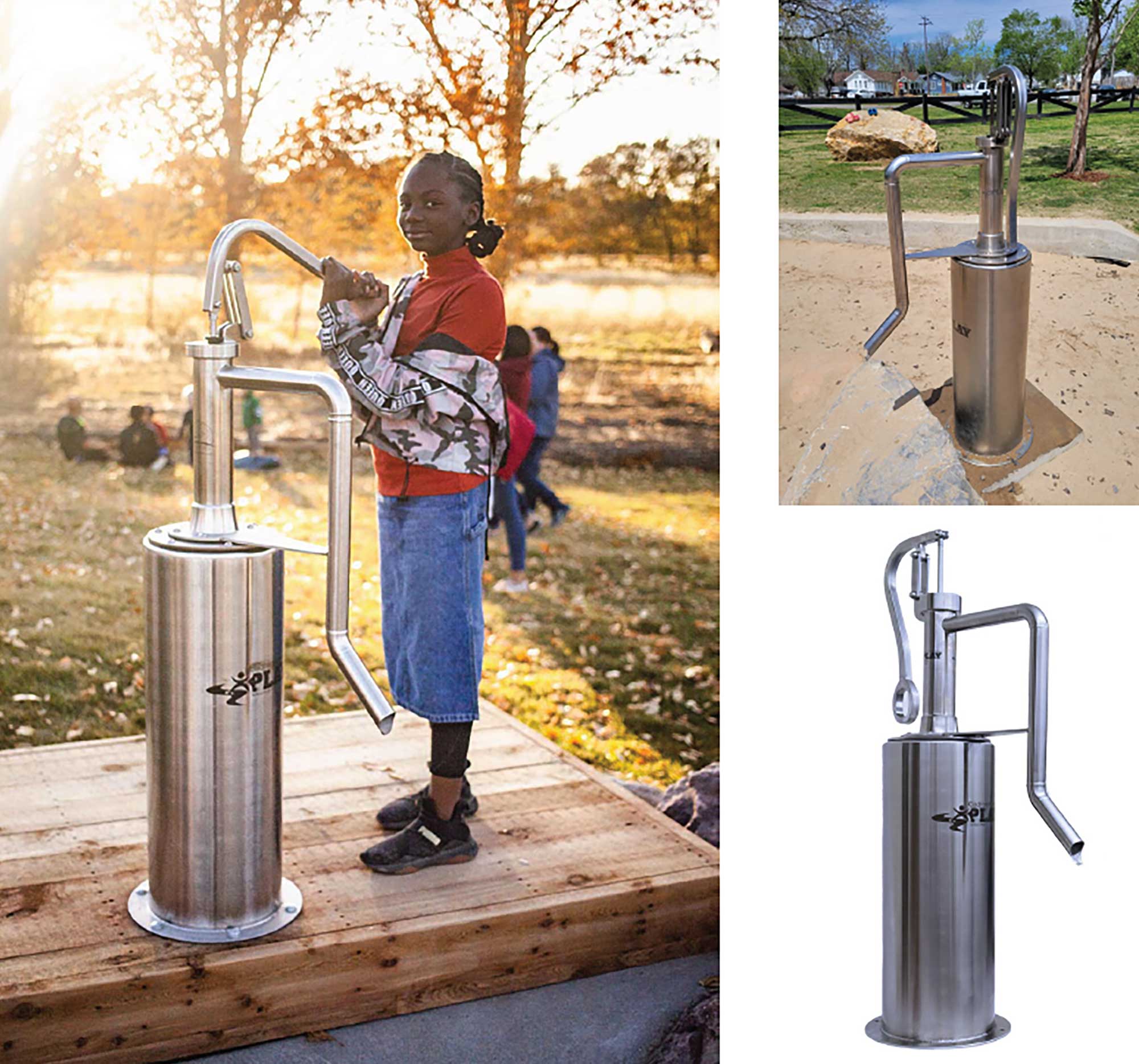
By capturing, reusing, and efficiently using water, landscapes can remain healthy and vibrant while reducing demand on drinking water supplies. These sustainable strategies not only conserve water but also support natural hydrology, enhance habitat, and create functional, attractive spaces for people and wildlife alike.
Conclusion
Water is a vital part of every landscape, shaping ecosystems, supporting communities, and influencing how we live and interact with the environment. Thoughtful site design can turn water challenges into opportunities — reducing flooding, improving water quality, restoring streams and wetlands, and creating engaging, educational, and recreational features. At the same time, efficient water use, recycling, and conservation help maintain vibrant landscapes while protecting the water supply and supporting natural hydrology.
In the end, designing with water in mind benefits both people and the environment, creating landscapes that thrive now and for generations to come.
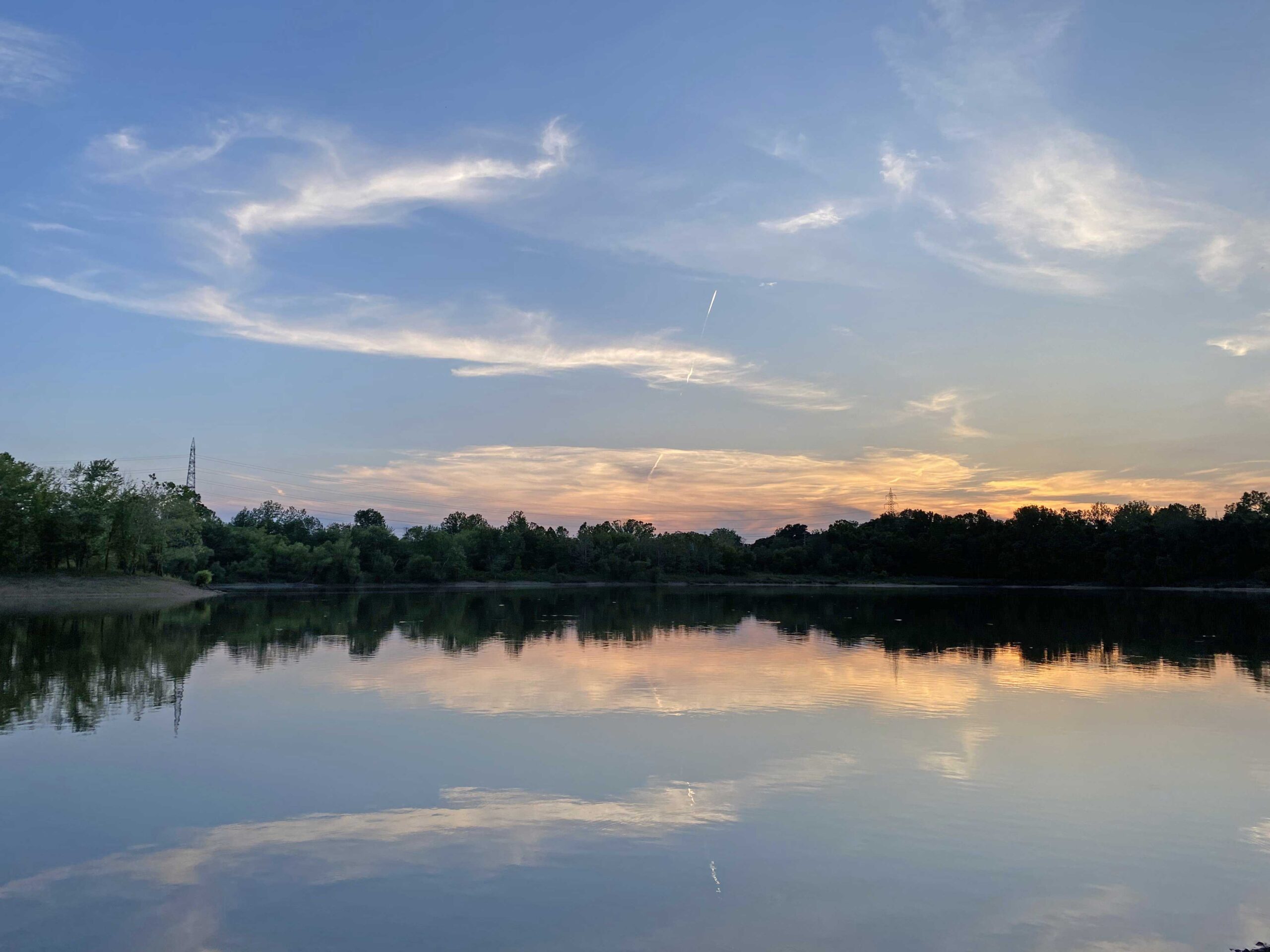
References
Calkins, Meg. The Sustainable Sites Handbook A Complete Guide to the Principles, Strategies, and Best Practices for Sustainable Landscapes. John Wiley & Sons, 2012.
Konrad, Christopher P. Effects of Urban Development on Floods. U.S. Geological Survey, November 29, 2016. https://pubs.usgs.gov/fs/fs07603/, accessed on August 13, 2025.
Oppedahl, Rachel. Water-Wise Water Features. University of California, 2019 https://ucanr.edu/sites/default/files/2019-08/307886.pdf, accessed on August 14, 2025.
Steiner, Frederick R., & Butler, Kent. Planning and Urban Design Standards Student Edition. John Wiley & Sons, 2007.